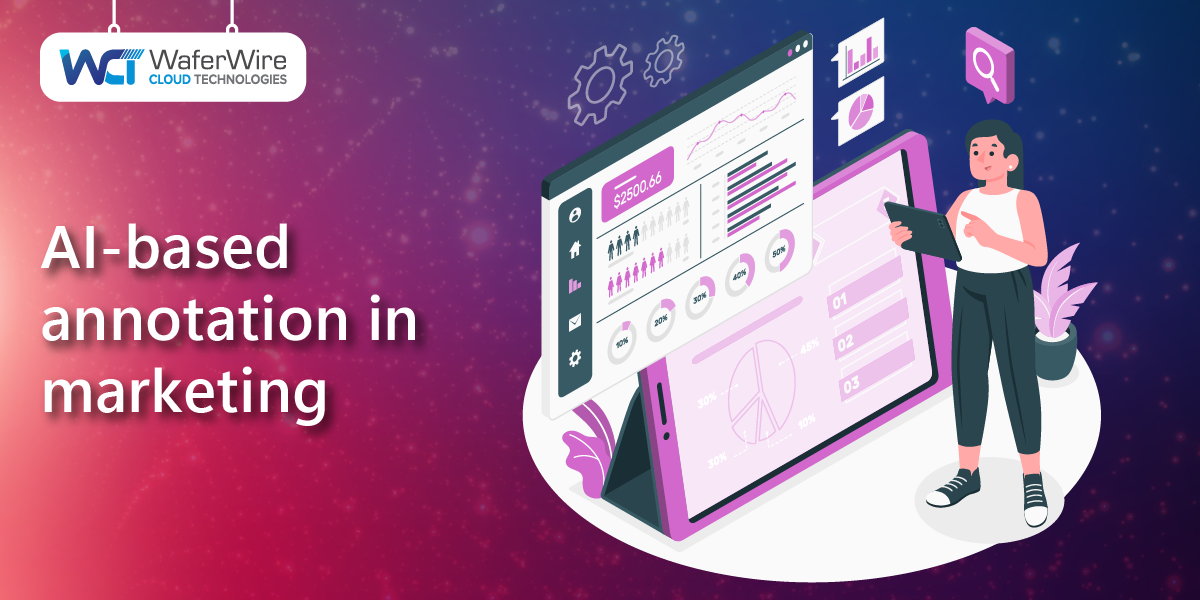Imagine you launched a new project management tool for small to medium-sized businesses. However, your marketing efforts failed to work for you. What could be the possible reasons?
- You ended up crafting fragmented content.
- Your content failed to resonate with your target audience.
Consequently, your audiences fail to connect with your product. The effect?
- Minimal interest
- No leads
- No sales
So, what would be a better solution? Personalization.
90% of leading marketers testified a personalization role in the bottom line.
So, how can you achieve this?
Here is where accurate annotations come into play.
What is an annotation?
Annotation tags your data to give additional details about the product. For example, you annotate your blogs in Cloud, Power BI, and Data Analytics. So, readers coming to your blog page find it easy to navigate and retrieve the content according to their preferences.

Another example is searching for people’s names in content as shown in the screenshot above. The tag ’people’ highlights all the names in the content.
However, to understand how it works for personalization, you must buckle up your seats!
While you visit a product page on an eCommerce site, you see recommendations and suggestions.

How does annotation happen?
While you visit Amazon to purchase a product, you might have clicked or viewed the product earlier. Also, there may be a chance of a second purchase of the same product. These clicks, views, and purchases are your interaction with the service. They show it as your interest in a product or a service. Online retail websites usually tags these user interaction with their products to help provide tailored recommendations based on the user preference.

Another example can be recommendations on historical purchases. Your customer is a regular health drink buyer from your retail store. So, the next time he shows up at your store, you can show relevant products or ads related to health drinks.
Also, by referring to your customers’ likes, dislikes, feedback, or comments, you can personalize search results.
Now, let us get back to our project management tool example.
A mid-sized company is looking for a project management tool to track financials. To pitch this company for your product, you must talk about annotating project budgets or expenses with categories, allocations, or cost breakdowns.
To annotate data to track finances, you can follow the steps below:
1) You can capture annotations within the project management tool by creating fields or attributes.
2) Create user-friendly interfaces to add, delete, or edit annotations within the tool.
3) Integrate this tool with financial systems to sync with the data.
4) Implement automation to categorize expenses based on predefined rules.
5) Create dashboards and reports to analyze spending patterns and trends.
6) Implement robust security features to allow specific users to access critical financial information.
7) Finally, check your tool excels in scaling and handling large volumes of financial data annotations.
Once you annotated the data, here comes marketing efforts to capitalize on this. You can:
- Identify customer needs.
- Create targeted messaging.
- Drive engagement with customized offerings.
- Personalize content
- Find the perfect timing for marketing outreach.
- Track the effectiveness of your tailored marketing efforts through responses and conversion rates.
Now, you know how to annotate data for a specific problem and harness this annotation for your marketing efforts. Now, let’s move ahead to see how to create these annotations.

- Customer reviews make sense to create annotations, and NLP takes the credit. It picks up these reviews and comments, analyzes the customer sentiments behind these reviews to extract meaningful information, and uses this information to annotate data.
- While annotating visual content, AI-based computer vision algorithms rescue you. With these algorithms, you can analyze videos and images in the form of objects, actions, and other relevant attributes and annotate the video content.
- What about creating annotations for similar data categories? Machine Learning (ML) is your solution. You can train your machine learning model on annotated data for crafting new annotations of new data.
- Let’s not forget about pattern recognition. It is like finding similar faces in the crowd! Either create data clusters with the same characteristics or find the relationship between different data attributes. Pattern recognition creates annotations that make sense of your data.
So, let’s cut to the chase.
Annotations help you to resonate with your audience, making your marketing efforts more productive. However, creating AI-based annotations for your unique problem can be a game changer. So, partnering with an AI expert is viable. Nevertheless, the choice is always yours!
Top 5 FAQs on data annotations for personalized marketing
What is it to annotate a text?
To annotate a text means to add extra information and insights to a text to make sense out of it.
How does annotation relate to personalized marketing?
In personalized marketing, data annotations help analyze customer sentiments, needs, preferences, and spending behaviors to tailor marketing strategies accordingly.
How does data annotation improve customer engagement?
Data annotation helps better understand customer needs and preferences and crafts targeted messaging to deliver personalized content to their audience.
How can businesses implement data annotation for personalized marketing?
Businesses can implement data annotation by using NLP, AI-based computer vision algorithms, machine learning models, and pattern recognition techniques.
What are the benefits of using AI-based annotations for personalized marketing efforts?
- Accuracy
- Deeper insights
- Better targeting
- Better customer experience
